What is Hypertrophic Cardiomyopathy?
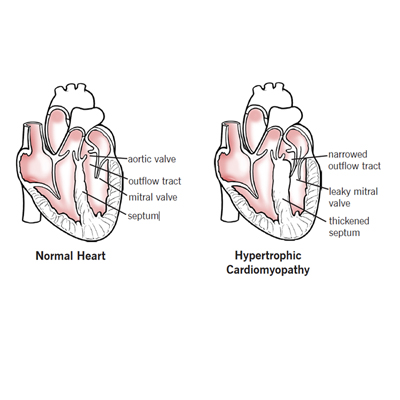
Hypertrophic cardiomyopathy (HCM) is a complex type of heart disease that affects the heart muscle. It causes thickening of the heart muscle (especially the ventricles, or lower heart chambers), left ventricular stiffness, mitral valve changes and cellular changes.
Thickening of the heart muscle (myocardium)
Occurs most commonly at the septum. The septum is the muscular wall that separates the left and right side of the heart. Problems occur when the septum between the heart’s lower chambers, or ventricles, is thickened. The thickened septum may cause a narrowing that can block or reduce the blood flow from the left ventricle to the aorta - a condition called “outflow tract obstruction.” The ventricles must pump harder to overcome the narrowing or blockage. This type of hypertrophic cardiomyopathy may be called hypertrophic obstructive cardiomyopathy (HOCM).
HCM also may cause thickening in other parts of the heart muscle, such as the bottom of the heart called the apex, right ventricle, or throughout the entire left ventricle.
Stiffness in the left ventricle
Occurs as a result of cellular changes that occur in the heart muscle when it thickens. The left ventricle is unable to relax normally and fill with blood. Since there is less blood at the end of filling, there is less oxygen-rich blood pumped to the organs and muscles. The stiffness in the left ventricle causes pressure to increase inside the heart and may lead to the symptoms described below.
Mitral valve changes
The narrowing of the left ventricular outflow tract disrupts the proper function of the mitral valve, resulting in outflow obstruction and increased pressure in the left ventricle.
The obstruction is the result of the mitral valve striking the septum. When this occurs, the mitral valve frequently leaks, causing the blood to go back into the left atrium.
Cellular changes
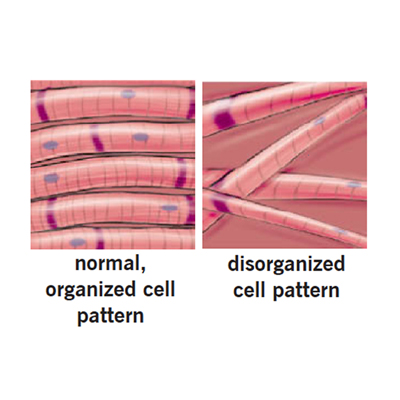
Hypertrophic cardiomyopathy causes cellular changes in the heart muscle. Through a microscope, the cells appear disorganized and irregular (called “disarray”) instead of being organized and parallel. This disarray may cause changes in the electrical signals traveling through the lower chambers of the heart and lead to ventricular arrhythmia (a type of abnormal heart rhythm).
Causes
What causes HCM?
- HCM can be inherited, caused by an abnormality in a gene that codes the characteristics for the heart muscle. There are many genes that can cause HCM. When a gene defect is present, the type of HCM that develops varies greatly within the family. In addition, some people who have the HCM gene may never develop the disease.
- Hypertrophy may be acquired as a result of high blood pressure or aging.
- In other instances, the cause of hypertrophy and HCM is unknown.
Because the cause of HCM varies, it is frequently difficult to identify a high-risk population.
Who is affected by HCM?
Hypertrophic cardiomyopathy affects an estimated 600,000 to 1.5 million Americans, or one in 500 people. It is more prevalent than multiple sclerosis, which affects one in 700 people.
Conditions & Symptoms Associated
What are the conditions associated with HCM?
Many people with HCM live a normal life and do not experience health-related problems. Other people with HCM may develop heart conditions that shorten life or decrease the person’s quality of life, including:
- Sudden cardiac arrest and sudden cardiac
death: Sudden cardiac arrest is a sudden loss
of heart function caused by a dangerously fast
heart rhythm called ventricular tachycardia.
Unless emergency treatments, including CPR
and defibrillation, are initiated immediately
after the onset of symptoms, sudden cardiac
death can occur.
Most people with HCM have a low risk for sudden cardiac death. However, HCM is the most common cause of sudden cardiac death in people under age 30. HCM may be best known for its role in cardiac arrest and subsequent death in some young professional athletes. - Heart failure: A condition in which the heart’s pumping power is weaker than normal.
Associated Symptoms
Symptoms associated with the presence of ventricular tachycardia or heart failure include:
- Chest pain or pressure that usually occurs with exercise or physical activity, but also may occur with rest or after meals.
- Shortness of breath and fatigue, especially with exertion. These symptoms are more common in adults with HCM and are most likely caused by a backup of pressure in the left atrium and lungs.
- Syncope (fainting or passing out) may affect HCM patients. Syncope with HCM may be caused by irregular heart rhythms, abnormal responses of the blood vessels during exercise, or no cause may be found.
- Palpitations (fluttering in the chest) due to abnormal heart rhythms (arrhythmias) such as atrial fibrillation or ventricular tachycardia. Atrial fibrillation occurs in about 25 percent of those with HCM, and increases the risk for blood clots and heart failure.
Diagnosis
How is HCM diagnosed?
The diagnosis of HCM is based on:
- Medical history: Your doctor will ask you questions about your symptoms and family history.
- Physical exam: Your doctor will listen to your heart and lungs. Patients with hypertrophic obstructive cardiomyopathy (HOCM) may have a heart murmur.
- Tests: An echocardiogram is the most common test used to diagnose HCM, as the characteristic thickening of the heart walls is usually visible on the echo. Other tests may include blood tests, electrocardiogram, chest X-ray, exercise stress echo test, cardiac catheterization and magnetic resonance imaging (MRI).
Treatments
How is HCM treated?
The type of HCM treatment prescribed depends on:
- Whether there is narrowing in the outflow tract (the path blood travels to leave the heart)
- How the heart is functioning
- The patient’s symptoms
- The age and activity level of the patient
- The presence of arrhythmias
Treatment is aimed at minimizing or preventing symptoms and reducing the risk of complications, such as heart failure and sudden cardiac death.
Treatment includes risk identification and regular follow-up, lifestyle changes, medications and procedures, as needed.
At Cleveland Clinic, we’re always researching and testing new treatments and therapies, including emerging gene therapies. We're also actively involved in many clinical trials that test new drugs, surgery techniques and treatments before they’re widely available.
Risk Identification
Most people with HCM have a low risk for sudden cardiac death. However, it is important to identify the small number of patients with HCM who do have a higher risk for sudden cardiac death, so preventive measures can be taken.
People with HCM who have a higher risk for sudden cardiac death include:
- Patients who have a family history of sudden cardiac death
- Young patients who have had several episodes of syncope (fainting)
- Patients who experience an abnormal blood pressure response with exercise
- Patients who have a history of arrhythmia with a fast heart rate
- Patients with severe symptoms and poor heart function
Your doctor can discuss your personal risk. If you have two or more risk factors for sudden death, your doctor may prescribe preventive treatments such as antiarrhythmic medications or an implantable cardioverter defibrillator (ICD) to reduce your risk.
Medications
Medications are often prescribed to treat symptoms and prevent further complications. Mavacamten is the first FDA-approved drug specifically developed to target HCM. This innovative medication makes it easier for your heart to pump blood to the rest of your body. It has proven to have great success in reducing the symptoms of HCM and is often used as an alternative to surgery. Other medications may be prescribed as needed to relax the heart muscles, control your heart rate or decrease the occurrence of arrhythmias.
You may be told to avoid certain medications, such as nitrates, because they lower blood pressure, or digoxin, because it increases the force of the heart’s contraction.
Antibiotic medications may be prescribed to reduce the risk of bacterial endocarditis, a potentially life-threatening condition (see other precautions).
Procedures
Procedures for the treatment of hypertrophic obstructive cardiomyopathy include septal myectomy, ethanol ablation, implantable cardioverter defibrillator (ICD) and heart failure management, as needed.
Septal Myectomy
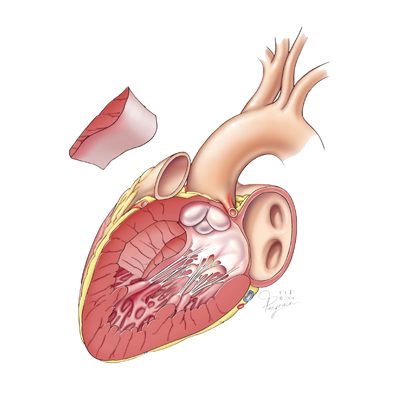
Septal myectomy is a surgical procedure performed to reduce the muscle thickening that occurs in patients with hypertrophic cardiomyopathy. Septal myectomy is one treatment option for HCM when symptoms persist despite optimal treatment with medications, or if obstruction severely restricts blood ejection from the heart.
During a septal myectomy, the surgeon removes a small amount of the thickened septal wall to widen the outflow tract (the path the blood takes) from the left ventricle to the aorta. This eliminates the obstruction and the mitral valve regurgitation that occurs with this condition. Patients often experience rapid relief of symptoms after the procedure.
Ethanol Ablation
This procedure, also called septal ablation, is reserved for patients who are not eligible candidates for septal myectomy. The ablation procedure is performed in the cardiac catheterization laboratory. First, the small coronary artery that supplies blood flow to the upper part of the septum is located during a cardiac catheterization procedure. A balloon catheter is inserted into the artery and inflated. A contrast agent is injected to locate the thickened septal wall that narrows the passageway from the left ventricle to the aorta. When the bulge is located, a tiny amount of pure alcohol is injected through the catheter. The alcohol kills the cells on contact, causing the septum to shrink back to a more normal size over the following months, widening the passage for blood flow.
Implantable Cardioverter Defibrillators (ICDs):
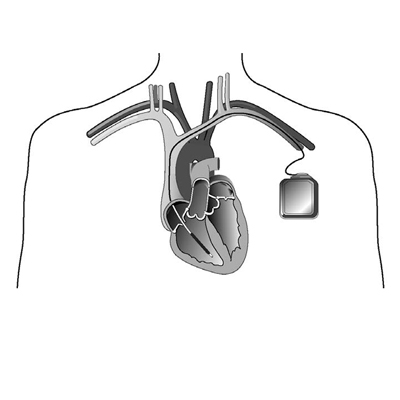
ICDs are suggested for people at risk for life-threatening arrhythmias or sudden cardiac death. The ICD is a small device placed just under the skin and is connected to wire leads that are threaded through the vein to the heart. An ICD constantly monitors the heart rhythm. When it detects a very fast, abnormal heart rhythm, it delivers energy (a small but powerful shock) to the heart muscle to cause the heart to beat in a normal rhythm again. Your doctor will tell you if an ICD is recommended.
Cleveland Clinic has one of the largest surgical practices for treating HCM. Our surgeons have been performing the septal myectomy procedure since 1967 and have performed over 1,600 myectomies to date. We perform more than 150 myectomy procedures each year.
What can I expect before the surgery?
Before your surgery date, you will have a presurgical appointment where you will receive specific instructions about when and where to report for surgery, what to expect before and after surgery, and whether additional tests are needed. If you need to see another health care provider or need testing during this preoperative appointment, you may be at Cleveland Clinic all day or you may need to return another day.
During this appointment, you will have the opportunity to talk with a nurse or patient educator about the procedure. You may also meet with your surgeon and anesthesiologist.
If you are already in the hospital and surgery is recommended, your health care team will give you information about pre-surgical tests and how to prepare for surgery.
What happens during surgery?
Anesthesia: General anesthesia is administered by a cardiothoracic anesthesiologist before surgery. The anesthesiology team uses state-of-the-art equipment and monitors to ensure you are safely anesthetized during the procedure.
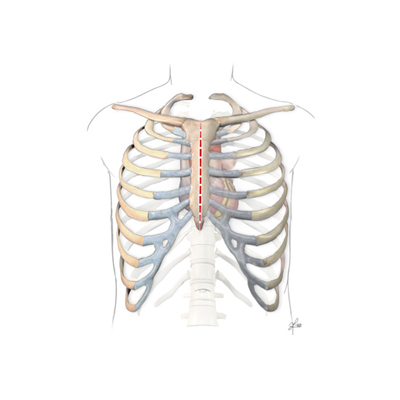
Type of incision: A 6- to 8-inch incision is made down the center of the chest, dividing the sternum (breastbone) to provide the surgeon direct access to the heart.
The thickened muscle is approached through the aortic valve so that no direct incisions into the heart muscle are required. The cut muscle heals on its own without needing to be sutured.
Heart-lung machine: The heart-lung machine, or cardiopulmonary bypass, is used during the procedure and takes over the heart’s normal functions so the surgeon can perform the procedure on a “still” heart.
Blood is routed through the heart-lung machine, and oxygen and carbon dioxide are exchanged in the blood by the machine and then pumped back into the body. By doing the work of the heart, the heart-lung machine helps protect your other organs while your heart is stopped. After the procedure is complete, the heart-lung machine is turned off, the heart starts beating on its own, and the flow of blood returns to normal.
Pacing wires: Temporary pacing wires and a chest tube to drain fluid are placed before the sternum is closed with special sternal wires. Then the skin and subcutaneous tissue is closed with internal, absorbable sutures. Sometimes a temporary pacemaker is attached to the pacing wires to regulate the heart rhythm until your condition improves.
How long does the surgery last?
The surgery lasts from 3 to 6 hours.
What should I expect after surgery?
You will be transferred to an intensive care unit for close monitoring for about one to two days after the surgery. The monitoring during recovery includes continuous heart, blood pressure and oxygen monitoring and frequent checks of vital signs and other parameters, such as heart sounds.
After you are transferred to the nursing unit, the hospital stay is about 3 to 5 more days. You will work with a cardiac rehabilitation specialist who will help you gradually increase your activity to aid your recovery. You can expect to stay in the hospital a total of 5 to 7 days, depending on your recovery.
Some patients may require an implantable cardioverter-defibrillator (ICD) to treat a serious abnormal heart rhythm. If this device is required, your cardiologist will discuss the details about the device and the implantation procedure.
Under certain circumstances, you may have a test called an EP study (electrophysiology study) before you go home to evaluate your heart rhythm.
Before you leave the hospital, you will receive specific information about incision care, medications, activity and diet guidelines, warning signs to look for and who to call after you go home.
Medications after surgery: You will continue to take your preoperative medications, as directed, until your follow-up appointment when your cardiologist may make adjustments to your medications.
Will my symptoms improve after surgery?
Yes. Surgical results indicate that most patients experience significant symptom improvement and an improved quality of life after surgery.
Recovery
Full recovery from septal myectomy surgery takes about 6 to 8 weeks. Most patients are able to drive in about 3 to 8 weeks after surgery. Your doctor will provide specific guidelines for your recovery and return to work.
Follow Up Care
After you are discharged, you will need to see the surgical nurse clinician within 5 to 7 days to ensure you are healing properly. We also will call you periodically to evaluate your postoperative progress.
Continue with your regular heart follow-up appointments with your local cardiologist or with your Cleveland Clinic cardiologist. These regular follow-up appointments are important to evaluate your heart function and include a medical exam as well as diagnostic tests (such as an echocardiogram). During these appointments, your medications may be adjusted to relieve symptoms or optimize your heart function.
Even if you are not having symptoms and you feel fine, you must still see your doctor regularly. The frequency of your follow-up visits is based on your current health. In general, you will need to see your cardiologist for follow-up visits at least twice a year.
During the first few months after surgery, you will probably need to visit a few times with the doctor who referred you for surgery. You will need to schedule regular appointments with your cardiologist (even if you have no symptoms).
You should call your doctor if your symptoms become more severe or frequent. Don’t wait until your next appointment to discuss changes in your symptoms.
Lifestyle Changes
Certain lifestyle changes, as listed below, are essential for properly managing HCM.
- Fluid and sodium restrictions may be necessary for some patients if heart failure symptoms are present. Ask your doctor for specific fluid and dietary guidelines, including information about alcoholic beverages and caffeinated products.
- Exercise. Your doctor will discuss exercise guidelines with you. Most people with hypertrophic cardiomyopathy are able to participate in noncompetitive aerobic activities. Heavy weight lifting and many high-intensity sports are not recommended.
- Regular Follow-Up Visits. Patients with HCM should follow up regularly with their cardiologist, as recommended, to monitor their condition.
- Reduce the Risk of Infection. See below about precautions to take if you are at risk of developing infective endocarditis.
Infective Endocarditis Precautions
If you have HCM, you have an increased risk of developing bacterial or infective endocarditis.
Bacterial or infective endocarditis is an infection of the heart valves or the heart’s inner lining (endocardium). It occurs when germs (especially bacteria, but occasionally fungi and other microbes) enter the blood stream and attack the lining of the heart or the heart valves. Bacterial endocarditis causes growths or holes on the valves or scarring of the valve tissue, most often resulting in a leaky heart valve. Without treatment, bacterial endocarditis can be a fatal disease.
To Reduce Your Risk:
- Practice good oral hygiene habits every day. Take good care of your teeth and gums by seeking professional dental care every six months, regularly brushing and flossing your teeth, and making sure dentures fit properly.
- Call your doctor if you have symptoms of an infection, including a fever over 100 degrees F; sweats or chills; skin rash; pain, tenderness, redness or swelling; wound or cut that won’t heal; red, warm or draining wound; sore throat, scratchy throat or pain when swallowing; sinus drainage, nasal congestion, headaches or tenderness along upper cheekbones; persistent dry or moist cough that lasts more than two days; white patches in your mouth or on your tongue; nausea, vomiting or diarrhea.
- Don’t wait to seek treatment. Colds and the flu do not cause endocarditis, but infections, which may have the same symptoms, do cause endocarditis. To be safe, call your doctor.
- Cleveland Clinic cardiologists believe it is important for patients with HCM to take preventive antibiotics before certain medical and dental procedures, in addition to following the steps above to reduce your risk. Please talk to your doctor about the type and amount of antibiotics you should take, and for what procedures you should take them.
- A bacterial endocarditis identification card is available from the American Heart Association and should be carried with you. Ask your doctor for a card or go to www.americanheart.org and search for “bacterial endocarditis wallet card.”
Importance of Making Lifestyle Changes
To maintain your health after surgery, it is important to take medications as prescribed and make lifestyle changes as recommended by your doctor to reduce the risk of disease progression or future disease. Lifestyle changes include:
- Eat a heart-healthy diet that includes following a 2,000 mg sodium (salt) diet
- Restrict fluids to 8 cups or less per day
- Quit smoking and using tobacco
- Treat high cholesterol
- Manage high blood pressure and diabetes
- Exercise regularly
- Maintain a healthy weight
- Weigh yourself every day and monitor for sudden weight gain of more than 2 pounds in a day or 5 pounds in a week; call your doctor if this occurs
- Control stress and anger
- Participate in a cardiac rehabilitation program, as recommended
- Follow up with your doctor regularly, as scheduled
Patient Services
Support is Available
The Hypertrophic Cardiomyopathy Association (HCMA) is dedicated to providing support and education to those with HCM, their families and other health care professionals.
- Visit the website at www.4hcm.org
Contact:
P.O. Box 306
Hibernia, NJ 07842
973.983.7429
E-mail: support@hcma-heart.com
For More Information
For more information about hypertrophic cardiomyopathy and treatment options, please visit our website at www.clevelandclinic.org/heart or e-mail us using the Contact Us form.
To talk with a nurse about hypertrophic cardiomyopathy and available treatment options, please contact the Heart, Vascular & Thoracic Resource Center Nurse toll-free at 866.289.6911.
To make an appointment, please call 800.659.7822.
MyConsult® Online Medical Second Opinion
MyConsult Online Second Opinion program connects patients to the expertise of top Cleveland Clinic specialists without the time and expense of travel. Through our secure web platform, patients can submit their detailed health information, medical records and diagnostic test results. The most appropriate Cleveland Clinic expert is assigned to the consultation and will render a detailed second opinion. The report includes commentary about the diagnosis and treatment options or alternatives and recommendations regarding future therapeutic considerations. Patients are also able to send additional questions to the physician who provided the report. Online medical second opinions are available for more than 1,200 medical diagnoses.
Chat with a Heart Nurse
For over 15 years heart, vascular & thoracic resource nurses have been offering assistance to people who have questions or concerns about heart, vascular and thoracic conditions. Nurses are available to help with questions on symptoms, diagnoses, treatment options, Cleveland Clinic services and doctors, etc. The nurses are available weekdays from 8:30 a.m. – 4 p.m., Eastern Time, through phone, secure live chat or email. If you need help, you may contact a nurse.
Why Choose Us?
About the Sydell and Arnold Miller Family Heart, Vascular & Thoracic Institute
The Sydell and Arnold Miller Family Heart, Vascular & Thoracic Institute at Cleveland Clinic is one of the largest cardiovascular specialty groups in the world, providing patients with expert medical management and a full range of therapies.
Our areas of expertise combine research, education and clinical practice to provide innovative and scientifically based treatments for cardiovascular disease. The commitment of our physicians and scientists to the prevention and cure of cardiovascular disease has led to innovative care, better outcomes and improved quality of life for patients with cardiovascular disease.
This information is not intended to replace the medical advice of your doctor or health care provider.
Please consult your health care provider for advice about a specific medical condition.
Resources
Learn More
- Learn more about hypertrophic cardiomyopathy by visiting Cleveland Clinic’s Heart, Vascular & Thoracic Institute website
- Watch videos on hypertrophic cardiomyopathy presented by Cleveland Clinic specialists
- Sign up for our e-newsletter, and get tips on maintaining a heart healthy lifestyle, recipes and essential health news